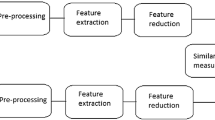Abstract
Content based image retrieval (CBIR) is an extrusive technique of retrieving the relevant images from vast image archives by extracting their low level features. In this research paper, the pursuance of five most prominent texture feature extraction techniques used in CBIR systems are experimentally compared in detail. The main issue with the CBIR systems is the proper selection of techniques for the extraction of low level features which comprises of color, texture and shape. Among these features, texture is one of the most decisive and dominant features. This selection of features completely depends upon the type of images to be retrieved from the database. The texture techniques explored here are Grey level co-occurrence matrix (GLCM), Discrete wavelet transform (DWT), Gabor transform, Curvelet and Local binary pattern (LBP). These are experimented on three touchstone databases which are Wang, Corel-5 K and Corel-10 K. The chief parameters of CBIR systems are evaluated here such as precision, recall and F-measure on all these databases using all the techniques. After detailed investigation it is figured out that LBP, GLCM and DWT provide highlighted and comparable results in all these datasets in terms of average precision. Besides practical implementation, the précised conceptual examination of these three texture techniques is also proposed in this article. So, this analysis is extremely beneficial for selecting the appropriate feature extraction technique by taking into consideration the experimental results along with image conditions such as noise, rotation etc.










Similar content being viewed by others
References
Sharma R, Singh EN (2014) Comparative study of different low level feature extraction techniques. Int J Eng Res Technol 3(4):1454–1460
Singh SM, Hemachandran K (2012) Content based image retrieval using color moment and Gabor texture feature. Int J Comput Sci 9(5):299–309
Murala S, Maheshwari RP, Balasubramanian R (2012) Local tetra patterns: a new feature descriptor for content-based image retrieval. IEEE Trans Image Process 21(5):2874–2886
Wang L, Wang H (2017) Improving feature matching strategies for efficient image retrieval. Signal Process Image Commun 53:86–94
Wang H, Feng L, Zhang J, Liu Y (2016) Semantic discriminative metric learning for image similarity measurement. IEEE Trans Multimed 18(8):1579–1589
Yadav AK, Roy R, Kumar AP (2015) Survey on content based image retrieval and texture analysis with Aplications. Int J Signal Process, image Process Pattern Recognit 7(6):41–50
Liu GH, Yang JY (2013) Content-based image retrieval using color difference histogram. Pattern Recogn 46(1):188–198
Fadaei S, Amirfattahi R, Ahmadzadeh MR (2017) New content-based image retrieval system based on optimised integration of DCD, wavelet and curvelet features. IET Image Process 11(2):89–98
Prabhu J, Kumar JS (2014) Wavelet based content based image retrieval using color and texture feature extraction by gray level Coocurence. J Comput Sci 10(1):15–22
Sumana I and Islam M (2008) Content based image retrieval using curvelet transform, in proceedings of international IEEE conference on signal process. 2008: 11–16.
Jin C, Ke SW (2017) Content-based image retrieval based on shape similarity calculation, 3D res. Springer 8(3):1–19
Verma M, Raman B (2016) Local tri-directional patterns: a new texture feature descriptor for image retrieval, digit. Signal process. Rev J 51:62–72
Murala S, Maheshwari RP, Balasubramanian R (2012) Local tetra patterns : a new feature descriptor for content-based image retrieval. IEEE Trans Image Process 21(5):2874–2886
Alsmadi MK (2017) An efficient similarity measure for content based image retrieval using memetic algorithm. Egypt J Basic Appl Sci 4(2):112–122
Rashedi E, Nezamabadi Pour H, Saryazdi S (2013) A simultaneous feature adaptation and feature selection method for content-based image retrieval systems. Knowledge-Based Syst 39:85–94
Mosbah M, Boucheham B (2017) Distance selection based on relevance feedback in the context of CBIR using the SFS meta-heuristic with one round, Egypt. Informatics J 18(1):1–9
Sheshasaayee A, Jasmine C (2014) Relevance feedback techniques implemented in CBIR : current trends and issues. Int J Eng Trends Technol 10(4):166–175
Shahbahrami A (2008) Comparison between color and texture features for image retrieval, 2008 6th Int. Symp Appl Mach Intell Informatics 27648:221–224
Srivastava D, Wadhvani R (2015) A review: color feature extraction methods for content based image retrieval. Int J Computational Eng Manag 18(3):9–13
Agarwal S (2013) Content based image retrieval using discrete wavelet transform and edge histogram descriptor, IEEE, Int. Conf. Inf. Syst. Comput. Networks: 19–23.
Chaudhari R, Patil A (2012) Content based image retrieval using color and shape features, nternational journal of advanced research in electrical. Electron Instrument Eng 1(5):386–392
Yang W, Sun C, Zhang L (2011) A multi-manifold discriminant analysis method for image feature extraction. Pattern Recogn 44(8):1649–1657
Chaoran C, Peiguang L, Xiushan N, Yilong Y, Qingfeng Z (2017) Hybrid textual-visual relevance learning for content-based image retrieval. J Vis Commun Image Represent 48:367–374
Zhao M, Zhang H, Sun J (2016) A novel image retrieval method based on multi-trend structure descriptor. J Vis Commun Image Represent 38:73–81
Sai N, Patil R, Sangle S (2016) Truncated DCT and decomposed DWT SVD features for image Retrieval,7th international conference on communication, computing and virtualization 2016. Procedia Comput Sci 79:579–588
Pavithra L K and SharmilaT S (2017) An efficient framework for image retrieval using color, Texture and edge features R, Int J Comput Electric Eng, 0: 1–14.
Prakasa E (2016) Texture feature extraction by using local binary pattern. INKOM 9(2):45–48
Al-Rawi SS, Sadiq AT and Ahmed IT (2011) Texture Recognition Based on DCT and Curvelet Transform, International Arab Journal of Information Technology: 1–5.
Author information
Authors and Affiliations
Corresponding author
Additional information
Publisher’s note
Springer Nature remains neutral with regard to jurisdictional claims in published maps and institutional affiliations.
Rights and permissions
About this article
Cite this article
Dhingra, S., Bansal, P. Experimental analogy of different texture feature extraction techniques in image retrieval systems. Multimed Tools Appl 79, 27391–27406 (2020). https://doi.org/10.1007/s11042-020-09317-3
Received:
Revised:
Accepted:
Published:
Issue Date:
DOI: https://doi.org/10.1007/s11042-020-09317-3




